THE South Australian Museum is one of the great assets of this State. But where is the Museum of South Australia?
Unlike SAM, which is a world-beating institution focussed on a series of specific subjects, a Museum of South Australia would display the artefacts, documents, and stories of South Australia, Adelaide, and what humans have created here.
For example, the Museum of Sydney “celebrates the people and events that have shaped the character and soul of this city.” There are similar museums in Brisbane and more recently in Perth.
SA has many attributes that make it unusual, and has many elements that can be found nowhere else.
But one problem confronting such a museum is the diverse nature of what we might call the South Australian Collection. It is dispersed to an almost spectacular degree. There are dozens of museums and museum collections, ranging from National Trust collections in far-flung country centres to the SA Museum and the various History Trust museums in maritime, migration, automobile, specialities, while there are no shortage of voluntary museums of aviation, army transport, railways, military, police and the like. SA’s archives, libraries and galleries also include museum collections.
But one problem confronting such a museum is the diverse nature of what we might call the South Australian Collection. It is dispersed to an almost spectacular degree.
While the History Trust is a leading contender for its South Australiana collections, many items, for example, are in the Adelaide City Council Collection. Did you know the rapiers used by Light and his sparring partner, William Jacob, while sailing to Adelaide on the brig Rapid, are held by the City Council?
Some artefacts survived by chance. When nearly all Colonel Light’s papers were lost in a disastrous fire, it just happened that he had sent off his first watercolour paintings of the colony to Britain, and they survived and have since been returned.
As the digital logging and recording of our heritage continues, it might soon be possible to assemble a virtual collection of South Australiana on line. But nothing beats the sense of awe in viewing the original.
A Museum of South Australia would have a constantly changing array of key exhibits selected from all our museums. But how is this list for starters?
We also pose the question of future museum objects. Should Jimmy Barnes’ sweaty headband be there? How about Humphrey Bear’s hat? Or a pie floater?
A
Adelaide Hunt Club Cup, 1870, H Steiner, AGSA.
The first horse race in SA was at Thebarton in 1838 and extravagant gold cups designed and made by local jewellers such as this one show how horses were central to the State’s early development and lifestyle.
2 Adelaide Mosque, Little Gilbert Street, Adelaide
Australia’s oldest surviving mosque was funded by the “Afghan” cameleers who had come to Australia with their camels to open up the arid pastoral lands of the interior. The mosque was built in 1888/89 and the minarets added in 1903.
3 The Adelaide Pound, City of Adelaide Collection
The creation of the Adelaide Pound staved off a financial crisis in SA caused by the Victorian Gold Rush when about 16 per cent of the population left the State almost overnight. SA announced it would take bullion by armed escort from the gold fields and force banks to back their notes with bullion. Most pounds were melted, making mint examples rare and valuable.
4 Dame Judith Anderson at Her Majesty’s Theatre, Adelaide, in 1915 SA Performing Arts Collection
SA’s most famous actress left costumes and scrapbooks and theatre programs to the collection.
5 Annie Watt SA Maritime Museum
The last wooden ketch to sail in SA waters, the Annie Watt was built in Tasmania in 1870 and worked in SA Waters from 1873 to 1971. Now in storage in hope of restoration.
6 Apron, Adelaide Central Market, 2018
Adelaide’s prime food outlet, meeting place and tourism attraction has made its name from its scores of traders. The neighbouring Market Arcade is returning to City Council ownership, offering a new chapter of development ahead of its 150th anniversary in 2019.
7 Australian Giant Cuttlefish, Spencer Gulf.
The annual migration of the Australian Giant Cuttlefish to the waters of the upper Spencer Gulf sees Giant Cuttlefish interact and dance during their mating ritual at the Arrium breakwaters near Whyalla.
8 Australian Jazz Quartet/Quintet
Three South Australian jazz players emerged as one of America’s top jazz bands in the 1950s.
Adelaide born Errol Buddle and Jack Brokensha, together with Bryce Rohde, from Hobart, played in Adelaide’s booming jazz scene of the early 1950s before establishing themselves in the US with American Dick Healey. They toured nationally there with Dave Brubeck, Thelonius Monk and Billie Holiday.
B
9 Baggage label, Gulf Trip, South Australian Maritime Museum.
From 1910 to the 1960s the Gulf Trip on Adelaide Steamship vessels was an exciting way to see SA. Popular with honeymooners and notorious party ships for young men, the seven-day trip cost £6 in 1939.
10 Barnesy’s sweaty bandanna, Japan, 1980
Elizabeth rocker Jimmy Barnes had fallen for Jane Mahoney in 1979 but she found the attention overwhelming and moved to Japan to be with her diplomat father. Jimmy followed, writing songs such as Rising Sun for his East album that year, and wearing a bandanna covered in Japanese characters to impress Jane. 10 years later he was told the writing had been upside down.
11 Blacksmith’s Book, 1858 Museum of Migration and Settlement.
Barossa Valley grower and blacksmith Johann Sporn recorded all his apricot and grape sales from his Light’s Pass farm from 1858 to 1928. SA had proved productive for horticulture and market gardening from its earliest days.
12 Kym Bonython by John Brack. National Portrait Museum
When the Ash Wednesday killed 28 South Australians and a further 45 Victorians in February 1983, it also raced up to Mount Lofty and wiped out many grand mansions including the Bonython family home, Eurilla, where adventurer, speedway racer and art patron Kym Bonython lived. It destroyed one of the great collections of 20th century Australian art and Australia’s biggest collection of jazz recordings, 5000 in all, signed by the artists. Just one painting survived, John Brack’s portrait of Kym Bonython. In 2007 he gave it to the National Portrait Gallery.
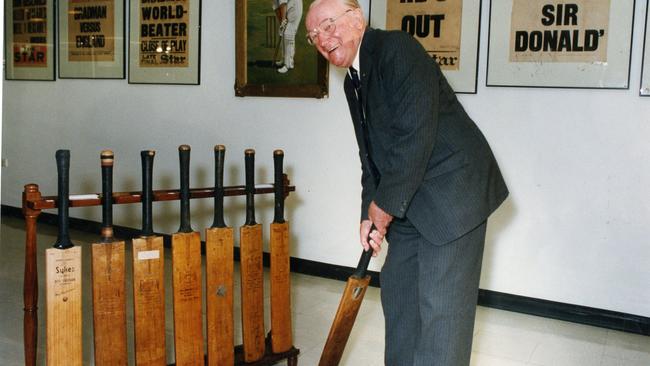
13 Bradman’s bats: Bradman Museum
Don Bradman made his test debut against England in the 1928-29 season. He scored 18 and one, and Australia lost the first test by the biggest margin of any Ashes series, before or since. By the end of the series he was world famous. He moved to SA from NSW in 1934 and lived out his days here.
C
14 City of Adelaide clipper, Port Adelaide
The world’s oldest surviving composite (steel and wood) clipper ship was launched in Sunderland, England, in 1864. It made 23 trips to Adelaide from the UK and brought many immigrants here. It is now in restoration at Port Adelaide.
15 Chinese Proclamation, Migration and Settlement Museum
Ever since the 1850s gold rush, overseas Chinese were an important part of SA society. This ornate thankyou note, sent to Adelaide from China in 1889, praised Adelaide Chinese for the funds they raised to help flood victims in the Jiangsu and Anhui provinces.
16 Cobdogla Pump, Cobdogla Irrigation and Steam Museum
The two huge Humphrey Pumps installed at Cobdogla on the River Murray in 1923 drove irrigation in the region by pumping up to a massive 320 megalitres a day from the river. The remarkable design is based on the internal combustion engine, moving water rather than pistons and crankshafts.
17 Christmas Pageant floats
At the height of the Great Depression, in 1933, the owner of John Martins department store, Sir Edward (Ian) Hayward, decided to hold a Christmas pageant, taking his inspiration from a similar pageant held by Macy’s, New York’s biggest department store. The pageant is bigger and brighter than ever, and hundreds of thousands of South Australians turn out to see it each year.
18 Caroma dual flush toilet.
SA’s Austrian immigrant Charles Rothauser invented the plastic cistern for toilets as his answer to Adelaide’s corrosive water supply. He moved on to solve another SA problem - lack of water - by developing the dual flush toilet. It is used around the world and made his company, Caroma Industries, very successful.
19 Coopers Sparkling Ale. In pubs
The 150-year history of Coopers as SA’s beer export to the world very nearly came to an end in 2005, at the hands of an explosively hostile, legally labyrinthine, but unsuccessful takeover by Lion from the founding Coopers family. Coopers is now the only major Australian-owned brewer.
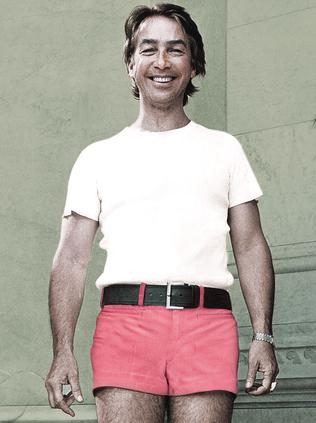
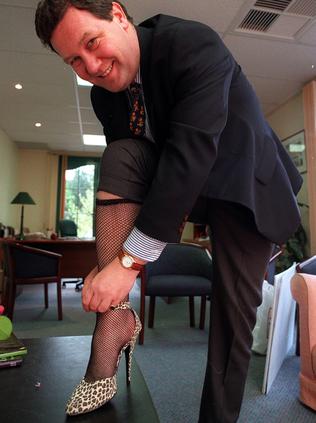
D
20 Demi Stanhope press, SA’s first printing press, History Trust of SA
Brought ashore at Holdfast Bay in 1836 it was set up in a tent and printed the first 100 copies of the Proclamation of SA
21 Dingley Dell, Port MacDonnell
In 1864 Adam Lindsay Gordon, regarded as one of Australia’s most influential poets, bought this now-restored cottage where he settled with his newlywed widwe a decade after arriving from the UK. He shone as a poet and was also a local legend for jumping his horse on to a ledge above Mount Gambier’s Blue Lake, a feat commemorated with a monument.
22 Alexander Downer in high heels and fishnet stockings, The Advertiser
High Commissioner to the UK, and former national leader of the Liberal Party, Adelaide’s Alexander Downer, caused an inordinate amount of fuss when he agreed to dress up for a Variety Club fund-raising stunt in November, 1996.
23 Dugout home, Coober Pedy
Diggers returning from World War I were attracted to Coober Pedy to mine for opals, and promptly began living in dugouts to escape the heat, and used to living underground by their time in the trenches. Modern tunnelling machinery make underground living common in the town.
24 Disposable syringe.
Adelaide’s pharmaceuticals company A.M. Bickfords & Sons, still famed for its cordials, was manufacturing Adelaide scientist Howard Florey’s newly developed penicillin from 1949. But steel and glass syringes clogged up. In 1951, Bickford’s employee Harry Willis suggested a one-use plastic syringe. He persuaded an innovative Adelaide plastic toy maker, Charles Rothauser (see Caroma dual flush toilets) to manufacture the world’s first successful disposable syringe.
25 Don Dunstan’s pink shorts. History Trust of SA, for Steven Chen
In 1972 South Australia’s Premier, Don Dunstan, strode into Parliament House on a summer’s day wearing pink shorts. There, his office did its best to hide him away from the media, but Don arranged to sneak out and proudly parade on Parliaments steps to a bevy of photographers, perhaps baiting South Australians with his ambiguous attitude to sexuality. They were definitely baited.
E
26 Australia’s first electroconvulsive therapy (ECT) machine, SA History Trust
Psychiatrist William Dibden was the first in Australia to use ECT, with a machine made in Adelaide in 1943.
27 Ediacaran Fossils
When Flinders Ranges grazier Ross Fargher stumbled across some sheets of fossil-bearing rock on his Nilpena Station he had no idea he’d found the earliest known multicellular animal life on Earth. Now, a 100 million year geological period from 635 to 542 million years ago bears an Aboriginal name, Ediacara, which refers to a place to find water.
28 Evaporative air conditioner: Seeley International
The dry, hot SA summers particularly suits evaporative airconditioners so it was no surprise that an Adelaide engineer and manufacturer, Frank Seeley, has come to dominate the world’s evaporative A/C business. They can cool a house with less power than most ceiling fans.
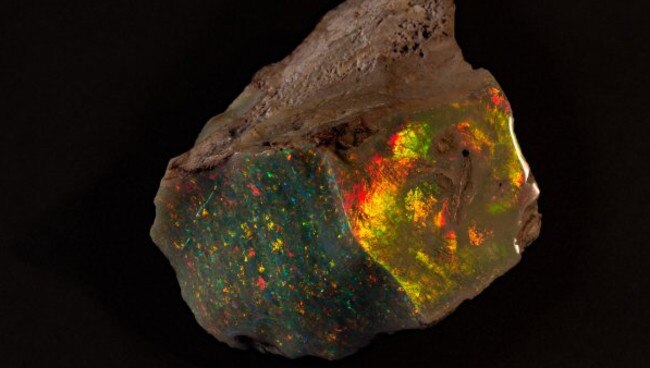
F
29 French map of South Australia, (La Terre Napoleon) following Nicolas Baudin’s 1802 visit. SLA.
Golfe Josephine and Golfe Bonaparte (St Vincent and Spencer) and dozens of other of the French names originally adorned our coast. Many French place names have survived. If the British and French had been less bellicose at that time we could have become bilingual, like the Canadians.
30 Football. First recorded football match in Adelaide, St Patrick’s Day, 1843
The village game with the oval ball was played in the parklands by up to hundreds of players, usually attended by brass bands, huge crowds and the colony’s governor and entourage. The game became refined as Australian rules football. In April 1877 SA was the first State to establish a football league, making SANFL (originally SA Football Association) one of the oldest leagues in the world in any football code.
31 Fire of Australia opal, SA Museum
Opal was first discovered in SA in 1915 at Coober Pedy, eventually making SA one of the biggest sources of the precious stone. The town is named “kupa piti” in the local language, commonly thought to mean “white man in a hole.”
32 Frog Cake
Balfours, long SA’s top brand for cakes, invented the frog cake in 1922 after one of the Balfour family was inspired by patisserie he saw in France. It quickly became a favourite, and was declared an SA icon in 2001. The recipe and frog-like shape haven’t changed in 96 years, but there are variations on the original light green colour
G
33 Golden North Giant Twins
The Bowker family formed one of SA’s enduring icecream brands after setting up shop in Laura in the Mid North in 1923 to supply markets including Broken Hill with milk and cream and icecream. The Giant Twins chocolate coated icecream bars are still popular. They used to be handmade in trays with a central indent so the company marketed Giant Twins to be broken in half to share. Its icecream competitor, Amscol, had Twin Chocs with two sticks. The Giant Twins indents are long gone, and so is Amscol, and there isn’t so much icecream sharing nowadays.
34 German wagon. Enfield Heritage Museum, Sunnybrae Farm.
German settlers began arriving in Adelaide in 1838, and gradually spread out across the State. They moved whole households in these slow and massive high-sided wagons, drawn by bullocks at one mile (1.6 km) an hour. Photo taken after restoration in 2004
35 Gold earring from Queens Theatre, Playhouse Lane, Adelaide. History Trust of SA
Mainland Australia’s oldest extant theatre opened in 1840 with a production of Othello and is still used as a theatre. An archaeological dig there in the 1990s found this earring.
36 Grange, 1951
In 1951 Penfolds winemaker Max Schubert made his first experimental vintage of the iconic Australian red wine that has won South Australia a place on the world map of great wine territories. Each remaining bottle is now worth tens of thousands of dollars.
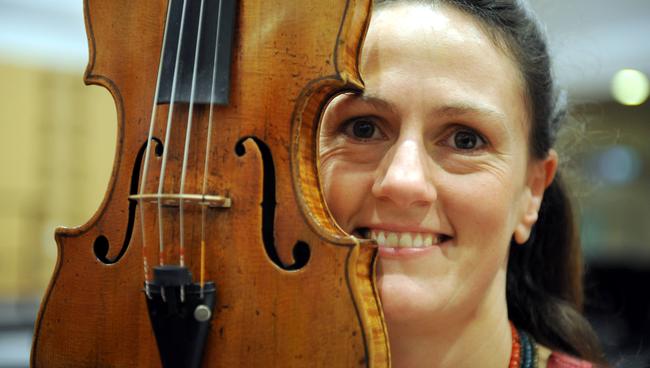
37 Guadagnini violin, SA Guadagnini Trust
In 1955 a public subscription campaign in SA championed by The Advertiser had raised £1750 to buy a rare Guadagnini violin for favourite SA violinist of the era, Carmel Hakendorf. The 1751 violin, now worth more than $1 million, continues to be loaned to SA violin virtuosos to help further their careers, presently in the hands of its fourth user, Sophie Rowell, associate concertmaster, Melbourne Symphony Orchestra.
38 Julia Gillard’s misogyny speech, Centre for Democracy, Kintore Avenue.
On October 9, 2012, Prime Minister and Adelaide’s own, Julia Gillard, finally lost her cool with her rival Tony Abbott’s constant sniping. ``I will not be lectured about sexism and misogyny by this man,’’ she said. If you go to the Centre for Democracy in the Institute Building on Kintore Avenue you can press the Gillard button and hear the speech. Alternatively, you can buy the tea towel.
39 Greater, the flamingo, SAM
When Adelaide Zoo favourite flamingo Greater died in 2014, aged 83, the SA Museum decided to mount the world’s longest-lived example of the Greater Flamingo, a challenge to the Museum’s taxidermists, who had never stuffed a flamingo before.
40 World’s first Gallipoli memorial, 1915, South Parklands,
Often termed “the forgotten Gallipoli memorial” the grieving women of Adelaide had this cenotaph erected in September 1915 in the memory of Australian soldiers after hearing of the bloodbath at “the Dardanelles” in April 1915.
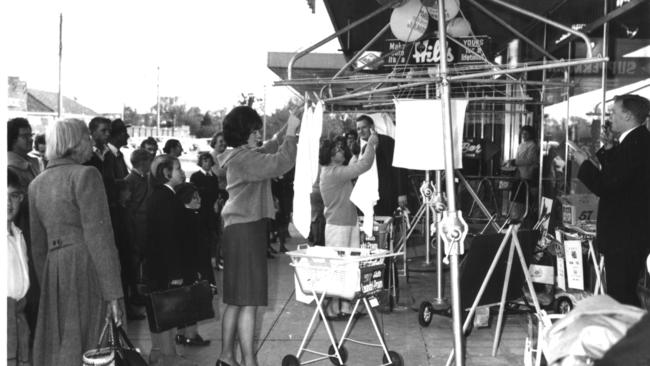
H
41 Hills Hoist. Ubiquitous
Developed in Adelaide in 1945 by Lance Hill, the rotary outdoors clothes dryer has invaded suburban landscapes across the world, sturdy enough to provide children everywhere a backyard playground and roundabout.
42 Holden’s first car 48/215 NMM
In 1948 General Motors-Holden began manufacturing the first Holden, the 48/215, later known as the FX. GM had acquired the coach building business of Adelaide’s Holden family in 1931. Holden’s had been manufacturing GM car bodies since 1923.
Listen: Heaps Good History podcast – Australian as they come - That’s Holden!
43 Sir Hans Heysen’s caravan, The Cedars, Hahndorf.
By 1926 Hans Heysen was already famous as an artist, and turned to the Flinders Ranges for inspiration. He made nine trips to the Flinders between 1926 and 1933, and a further two trips later on. He used his small caravan for the trips.
44 Hewitt’s Wimbledon winning racket
After a long time in the near-miss shadows, and a long drought since, Adelaide tennis ace Lleyton Hewitt seemed as amazed as everyone else when he finally gave Australia its spot in the tennis sunshine again in July, 2002. Pat Cash was the previous Australian winner — in 1987
45 Humphrey B Bear
After 50 years Humphrey Bear last appeared on television in 2009. The bear that never said a word but entertained generations of growing South Australians and national audiences, is believed to have mouthed that it was costing too much for the show to go on. The costume is still waiting a new wearer, but Humphrey may yet return as an animation, and with a voice at last.

J
46 Jindivik Target Drone, Woomera Rocket Park.
First tested at Woomera in 1952 Australia’s Jindivik would be used by airforces around the world. More than 500 have been made and exported so far.
K
47 Letters written to Germany in the Kaurna language by Kaurna mission children in 1843: University of Adelaide, Barr Smith Library.
A 12-year-old Kaurna boy, Wailtyi, was among children who wrote to Germany in copperplate script but in the Kaurna language, in the hope of being sent toys. The letters were returned to Adelaide on permanent loan in 2014 and are rare documents in the Kaurna language at the time.
L
48 Lake Eyre salt
In July 1964 driver Donald Campbell had settled on the vast salt plains of Lake Eyre for his “Bluebird” assault on the world record. He was the first man to top 400 mph or about 650 kmph in a wheel driven car over the measured mile. It took him a further 11 kilometres to get back under the speed limit.
49 Colonel Light’s Troughton Improved Level, RGS (SA)
Colonel William Light had learned the advantages of trigonometry for surveying while serving in the Peninsula War, and he put it to good use surveying Adelaide. The rapid advances in surveying equipment meant he soon moved on to a more accurate dumpy level, and his is held by the City of Adelaide Collection.
50 1975 national Lyrebird Award dress, George Gross and Harry Watt
In 1973, two young fashion designers, George Gross and Harry Watt, set up shop in SA to make fashion clothing, building a nationwide chain of fashion stores and clothing everyone from Joan Collins to Princess Diana.
M
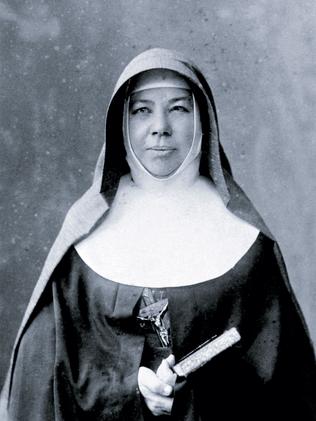
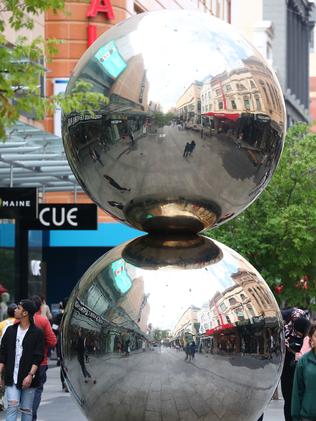
51 Mary MacKillop’s Rosary
Mary MacKillop was canonised a saint in 2010 by Pope Benedict XVI. She first came to Penola in SA in 1860 and began teaching there in 1866. She soon founded the Sisters of St Joseph dedicated to teaching young South Australian Catholics in particular. Mary incurred the displeasure of some within the Catholic church when she uncovered a pedophile priest in Kapunda in 1870 and was later excommunicated for two years for insubordination, but her Josephites were able to return to their work in 1872. A museum being founded in Adelaide in her honour will contain her desk and part of the habit she wore.
52 The Malls Balls, Bert Flugelman, Rundle Mall
Adelaide’s prime rendezvous spot consists of two large stainless steel balls, one balanced atop the other, and named for their prominent spot in Rundle Mall. When Bert, then a lecturer at the SA School of Art, installed them in 1977 he actually titled them Spheres. Locals prefer to say that Adelaide has balls.
53 Governor’s residence, Marble Hill
On Black Sunday, January 2, 1955, one of the State’s biggest bushfires took out the governor’s summer residence, and nearly took the governor with it, not to mention Premier Tom Playford who had to take cover in an open field at his Norton Summit home nearby. Marble Hill is finally being restored, with the help of Adelaide’s Michell family. The death toll of two was nothing like the State-wide devastation of Ash Wednesday, 1983.
54 Mawson’s sled, 1912-13, SA Museum.
SA’s famed geologist and explorer Douglas Mawson had to cut this Norwegian-made sled in half when he became the sole survivor of a three-man Antarctic crossing. Lieutenant Ninnis fell into a crevasse with most of their supplies and Xavier Mertz died as the remaining two made their long trek back to base, leaving Mawson unable to pull the whole sled.
55 PS Mayflower at Mannum, the oldest paddlesteamer in SA, built in NSW in 1884.
Actually Mary Ann, built of red gum north of Mannum in 1851 was the very first paddle steamer on the Murray but does not survive. Its boiler so terrified its builders they ran away as the steam pressure built up and hid in the bushes. Luckily, it worked.
56 Dame Roma Mitchell’s glasses and glass case, History Trust of SA
In 1965 Roma Mitchell became the first Australian woman to be a judge, appointed to the Supreme Court of South Australia. She was also the first woman Queen’s Counsel, the first woman chancellor of an Australian university and the first woman governor of an Australian state when appointed SA’s Governor in 1991.
57 A fragment of Mongers Mulberry Tree, RGS.
Regarded as the first tree ever planted in South Australia, it is possible that it pre-dates the settlement of SA and was planted by the motley crew of early European residents on the island. Similar very old mulberry trees, also possibly dating before settlement, have been found along SA’s coastline, suggesting some of our earliest European settlers didn’t like publicity.
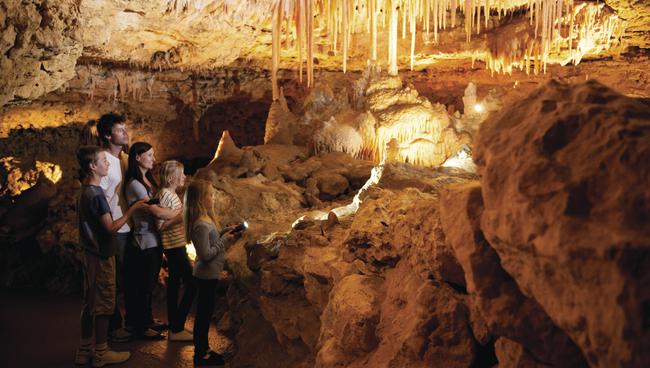
N
58 Naracoorte Caves
In 1994 the Naracoorte Caves became SA’s only World Heritage site. It remains our only World Heritage site to this day. Over 500,000 years random animals fell into or died in the caves leading to the most comprehensive record of Australia’s - and the world’s - fauna, spanning ice ages, the extinction of Australia’s megafauna, just 60,000 years ago and the arrival of humans. Four of the 28 caves found so far are open to the public
59 Ngarrindjeri weaving, AGSA and SAM
Basket weavers of Ngarrindjeri people in the Riverlands and Murray Mouth have a continuous tradition older than European civilisation. It was a close call when Ngarrindjeri artist Yvonne Koolmatrie worked with the last weaver to learn the techniques for her world famous art objects.
60 Errol Noack’s last letter: National Vietnam Veterans Museum, Phillip Island, Victoria.
On May 20, 1966 Adelaide National Serviceman Errol Noack wrote from Vietnam to his aunt Lois about his impressions after his first 10 days in the Vietnam War. By the time she received it on June 2, Errol was dead, shot down on May 24, the first Australian “Nasho” to die in the Vietnam War.
O
61 Lowitja O’Donoghue’s $1 postage stamp
In 1976, Lowitja O’Donoghue, born Lois O’Donoghue in SA’s remote Granite Downs in 1932, became the first Aboriginal woman to be awarded the Order of Australia. She was Australian of the Year in 1984. She also graces an Australia Post stamp.
P
62 Pie floater
An Adelaide delicacy, loved by gustatory adventurers around the world, the pie floater, a pie served floating in green pea soup, usually with a slash of Rosella tomato sauce to complete the picture, has managed to outlive the “pie carts” that sold them at all hours on the streets of Adelaide since the 1870s
63 Proclamation of the Province of SA. State Records.
Read out to the assembled settlers at Holdfast Bay by Robert Gouger on December 28, 1836, the Proclamation was particularly pointed in its references to protecting the rights of the “Native Population”.
64 Photocopiers. In your home and office.
In 1952, when “xeroxing” or dry photocopying was becoming all the rage in the US, two scientists at Adelaide’s branch of the Defence Standards Laboratories, Ken Metcalfe and Bob Wright, came up with a “wet” copying process that vastly improved the system and found many other uses besides. By the 1960s the annual patent fees for their invention well exceeded the cost of running DSL.

65 Playford’s power station. Port Augusta, now demolished.
South Australia learned to its cost during World War II that imported coal could not be relied upon and the city and industry was constantly subject to blackouts. Premier Tom Playford bit the bullet, nationalised the electricity business, and poured money into a Port Augusta power station linked to a new Leigh Creek coal field by a 250 kilometre railway line. For 70 years it was the mainstay of the State’s power supply.
66 Prairie A Eragny, by Camille Pissarro, Art Gallery of SA
In the late 19th century when the newly established Art Gallery of SA was busy collecting the best of Britain’s Victorian-era painters, it studiously ignored the revolution of French Impressionism taking place across the Channel. In 2014, it finally cracked, and bought a French Impressionist painting worthy of the name, albeit for $4.6 million.
R
67 RM Williams boots, well used
Back in 1932 Reg Williams was struggling to feed his family who were doing it tough in the Gammon Ranges station country. An old saddle maker and one-time horse thief, Dollar Mick, was welcomed to their shanty. Dollar Mick taught Reg how to make boots from a single piece of leather, and SA’s legendary stock and station outfitters was born, now owned by international brand Louis Vuitton.
68 Ridley Stripper, Adelaide Hills Motor Restoration Club
From 1842 when SA’s farm labourers, many of them experienced Cornish miners, discovered copper and gold, a drastic shortage of manpower to harvest grain crops resulted. A challenge was issued by the Agricultural and Horticultural Society of SA for a machine to harvest grain. Flour miller John Ridley developed his reaper-stripper in 1842/3, and in 1844 it won the A&HS prize. It is the most important technological development in agriculture of the era. All the world’s modern grain harvesters are descended from the Ridley Stripper, helped by John Ridley’s decision that it should be free of patent for all to use and further develop.
69 Rib-Loc plastic piping
Adelaide plastics engineer, Bill Menzel, developed the Rib-Loc system used in many countries to make new pipes and repair old ones. His solution was an extruded plastic tape that interlocked when laid in a spiral. It meant a whole pipeline could be transported as a large spool of plastic, and made at the site as it was laid. Furthermore, the spool could be fed out and expanded inside an existing faulty pipe until it re-sealed it. Since its introduction in 1984 it has become widely used around the world but hasn’t yet resolved the problem of Adelaide’s cracking water mains.
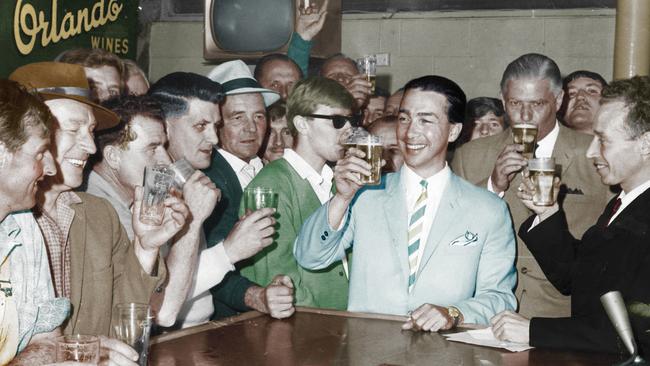
S
70 Shearer steam car, 1899 National Motor Museum.
The Shearer brothers, farm implement manufacturers at Mannum, had been building one of Australia’s earliest self-propelled vehicles in their spare time since 1884. They drove it to Adelaide where it paraded the streets and gave rides. It was also the last Shearer steam car.
71 Ship’s biscuit, SAMM
Hard tack or ship’s biscuit was an unappetising, but long-lasting food used on long sea voyages. It was usually a simple mixture of flour and water, with a dash of salt if you were lucky. More protein came from the weevils that often inhabited it.
72 Sia’s wigs
SA’s international rock music celebrity Sia, made anonymous by her wigs, has sparked an eBay craze for “Sia’s wigs”. The half blonde, half black wig with a fringe below the nose and a giant black bowtie on top sells for $15 plus postage.
73 Silver Epergne, 1788; SAMM
Adelaide Steamship Company emerged as Australia’s largest shipping company after being set up in 1875 by SA pastoralists and businessmen to better control exports and passenger services in SA. This antique silver epergne was bought to decorate the Adelaide offices of the company.
74 Six o’clock closing to end, Don Dunstan says: The Advertiser
SA, the once Wowser State, was the first to introduce early closing at 6pm, in 1916 during World War I after holding a referendum. It came to be known as the 6 o’clock swill. In September, 1967 SA was the last State to get rid of it.
75 Simpson washing machine, History Trust of SA
Before automatic washing machines, Adelaide white goods manufacturer Simpson was making the most labour saving device in the home, the washing machine with a powered wringer rather than the modern spin cycle. It was a hit across Australia.
76 Charles Sturt’s cannon. RGS.
This small cannon found at Gol Gol on the River Murray is probably the one taken by Charles Sturt on his epic voyage down the Murray in 1830.
77 Sturt desert pea
The floral emblem of South Australia grows mysteriously lush, brilliant and colourful in the outback after rain.
78 SOLA plastic spectacle lens.
Experimenting with the CR-39 plastic developed for World War II aircraft parts, Adelaide spectacles firm Laubman and Pank and the University of Adelaide came up with the first scratch resistant plastic spectacle lens. The company they formed, SOLA Optical, is now listed on the New York Stock Exchange, and is the world’s largest manufacturer of the lens.


79 South Australia’s Deed of Settlement, SLA
The signatories of this Deed of Settlement enabling the settlement of SA reads like a directory of Adelaide’s Streets, including Gouger, Waymouth, Currie, Pirie, Rundle and Angas.
80 South Australian Flag
In 1870 the colony of South Australia adopted its own flag. Variations followed until the present SA flag was adopted in 1904 with a piping shrike sharing the azure blue with a Union Jack.
81 Stainless steel teeth braces.
Adelaide dentist Percy Begg’s design for less intrusive braces in 1956 was adopted worldwide.
82 Stobie Pole. Everywhere
The lack of suitable timber in SA caused James Stobie, an engineer with the Adelaide Electric Supply Co, to invent the ugly but durable steel and concrete power line pole that would eventually bear his name. It was first used along North Terrace in 1924.
83 Storm Boy film set humpy, Goolwa, 1976
A humpy is a peculiarly Australian slang word that started as another word for an Aboriginal gunyah, but turned into something approaching a shack made from scrounged scrap. The Storm Boy humpy film set was built in the sand dunes along from Goolwa.
84 Stump-jump plough, Ardrossan National Trust Museum.
Developed by the Smith brothers of Ardrossan on Yorke Peninsula in 1859, the stump-jump share plough opened up vast new tracts of SA and later the rest of the world to agriculture. Previously, the deeply embedded mallee root stumps and the limestone reefs and rocks in many of SA’s agricultural districts had made ploughing there impractical even after the land was cleared.

T
85 Tasmanian Tiger, mounted, SAM.
Originally found in South Australia and Victoria as well as Tasmania, the thylacine was one of the early casualties of European arrival in Australia, made extinct through hunting in the 1930s. Now, thanks to samples held by the SA Museum among other institutions, geneticists offer the possibility that thylacines may one day be recreated.
86 Test Site, Totem 1, Emu Field
This obelisk with its radiation warning is at the site of Totem 1, the atmospheric test of an atomic bomb in October 1953 thought to have caused the “black mist” that afflicted so many Aborigines living and working in the remote South Australian northwest. The red phone on top is an Aussie irony not shared by North Korea or the US.
87 The Woman Suffers, 1918, National Film Archive.
An early film made in South Australia and one of the nation’s earliest features films was directed by Raymond Longford, and starred his partner, Lottie Lyell. It is a tale of mistaken identities, seductions and ruined women. It opened in Adelaide to rave reviews and screened widely, helping fund Longford’s next big film, The Sentimental Bloke (1919), based on the poems of SA’s most famous poet, C.J. Dennis.
88 Andy Thomas’s cosmonaut suit, SAM.
The Russian cosmonaut suit was used by SA scientist Andy Thomas during his time on the Russian Mir space station in 1998, making Andy a dual citizen of a very exclusive club.
89 Faith Thomas’s baggy green cap
In 1958 Faith Thomas, who was born and grew up on the Aboriginal settlement at Nepabunna in the Flinders Ranges, made her debut for Australia in women’s cricket, and so became the first Aboriginal sportsperson to represent Australia. She put her unexpected and deadly fast yorkers off a short run-up down to her past-time throwing rocks at galahs in the Flinders. Cricket Australia belatedly issued her with a baggy green cap in 2006.
U
90 Uranium oxide drums, SA’s Far North
In September 1988 the first yellowcake or uranium oxide began to be shipped out of the world’s biggest uranium mine, Olympic Dam, to Adelaide for export to Europe.
V
91 Vietnamese refugee boat, SAMM.
This model boat was hand-made by Vietnamese refugees, or “boat people” to South Australia while at the Pennington Migration Centre. In the aftermath of the Vietnam War after 1975 thousands of South Vietnamese refugees from the Communist takeover were to make the risky voyage to Australia.
92 Vickers Vimy Bomber, 1919, Adelaide Airport.
World War I saw the rapid development of the aeroplane. This one was used by the first Australians to fly from the UK to Australia. Sir Ross and brother Sir Keith Smith, both born in Adelaide, were knighted for the feat.
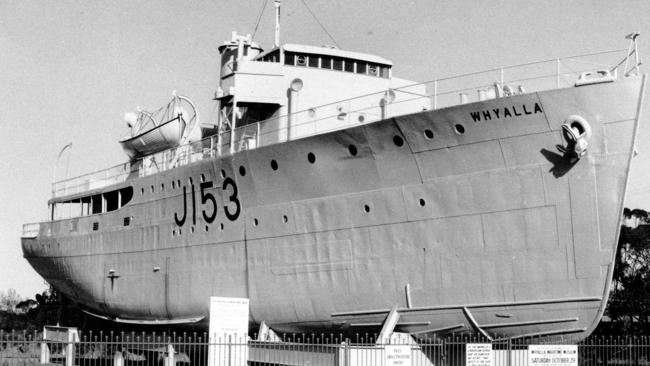
W
93 Arrest Warrant for Edward Gibbon Wakefield, National Museum of Australia
In 1826 the father of South Australia tried to win the fortune of a 15-year-old Ellen Turner by eloping with her. Given her dad was the High Sheriff of Cheshire, it was an ill-judged, though daring move, and Wakefield found himself in Newgate Prison, his very profitable marriage annulled. 1. Ediacaran fossils, South Australian Museum.
94 Wallaroo copper ingots, SA Museum
South Australia’s 19th century copper discoveries were so huge that that Wallaroo eventually became one of the busiest ports in Australia, if not the Southern Hemisphere, the main export point for copper from Kapunda, Burra and the copper triangle on Yorke Peninsula.
95 HMAS Whyalla. City of Whyalla, Whyalla
The first ship built at Whyalla shipyards was a corvette, launched in May, 1941 and in active service from early 1942. It worked until 1984, when the actual City of Whyalla bought it for $5000 and mounted it on its docks.
96 Winecask. Bottleshops
The collapsible bag of wine in a box was invented by Thomas Angove, of the Renmark based wine family, in 1935. However, cutting a flap in the winebag and pegging it up after use was a big ask for drinkers, and it fell to wine merchant and wine maker David Wynn to introduce the Airlesflow tap and popularise the winecask in 1970. It quickly won the attention of casual wine drinkers (and now packaged water drinkers) around the world.
97 Women’s vote petition, 1894, SA Parliamentary Library
SA was second in the world to give women the vote, in 1895, and first in the world to give them the right to stand for Parliament. The 11,600-signature petition included early activists such as Adelaide’s Muriel Matters who went on to sway public opinion on women’s suffrage in the UK.
98 Wyrie Swamp Boomerang, SA Museum
Australia’s oldest boomerang, about 10,000 years old, was finally located in a swamp near Millicent in the South East of SA in the 1970s after not coming back. The swamp has yielded Australia’s — and the world’s — oldest wooden artefacts.
X
99 X-Ray research spinthariscope of William Bragg, University of Adelaide Physics Museum Collection
In the years before the William and Lawrence Bragg won their Nobel Prize in physics for X-Ray diffraction, they were at the University of Adelaide investigating the properties of alpha particles produced by radioactive sources. This small instrument made in London by W Crookes in 1903 had been brought to Adelaide by a visiting scientist in 1904 and Bragg acquired it. It contains a small amount of the radioactive element radium near a scintillation screen so that it is possible to view the traces of alpha particles. At the time, William Bragg had begun experiments here to show that alpha particles passed through air atoms.
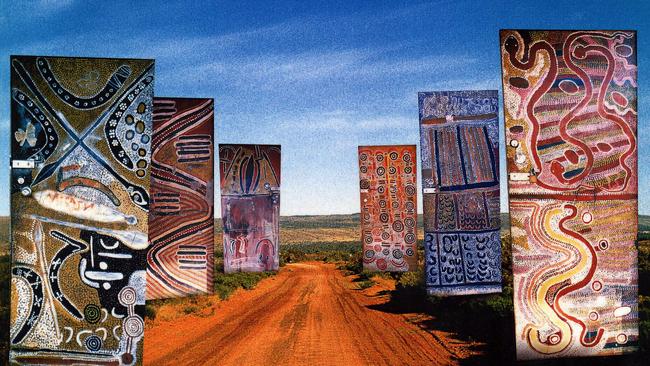
Y
100 Yuendumu Doors, SA Museum
In 1983 at Yuendumu in the Northern Territory the headmaster of the school asked the local old men to paint the doors of the school in order to discourage the rampant grafitti. What he got was 30 early masterpieces of the contemporary Aboriginal art movement based on the elders’ story cycles. By 1995, when the doors were in disrepair, SA Museum anthropologist Philip Jones set off on a mission to have them brought to Adelaide and restored by Artlab’s conservateurs.
Z
101 Zee-atlas showing SA’s coast, Amsterdam, 1658; Royal Geographical Society of SA.
The earliest Europeans known to visit to South Australia’s shores were with Pieter Nuyts aboard the Gulden Zeepaard, in January 1627. Pieter wasn’t impressed. He should have come in winter. His ship sailed from the west as far as Ceduna, mapping our shores. Maps of Australia from the 1640s included his work.
102 Zeta. NMM.
In 1963 Adelaide white goods manufacturer Harold Lightburn decided families needed a lightweight second car runabout, and came up with the Zeta, both as a sedan and a coupe. It had its detractors but many saw it as the seeds of an indigenous automotive industry. Buyers were fascinated to learn that it no reverse gear. You switched off the engine, started it again in reverse and then you had four reverse gears!

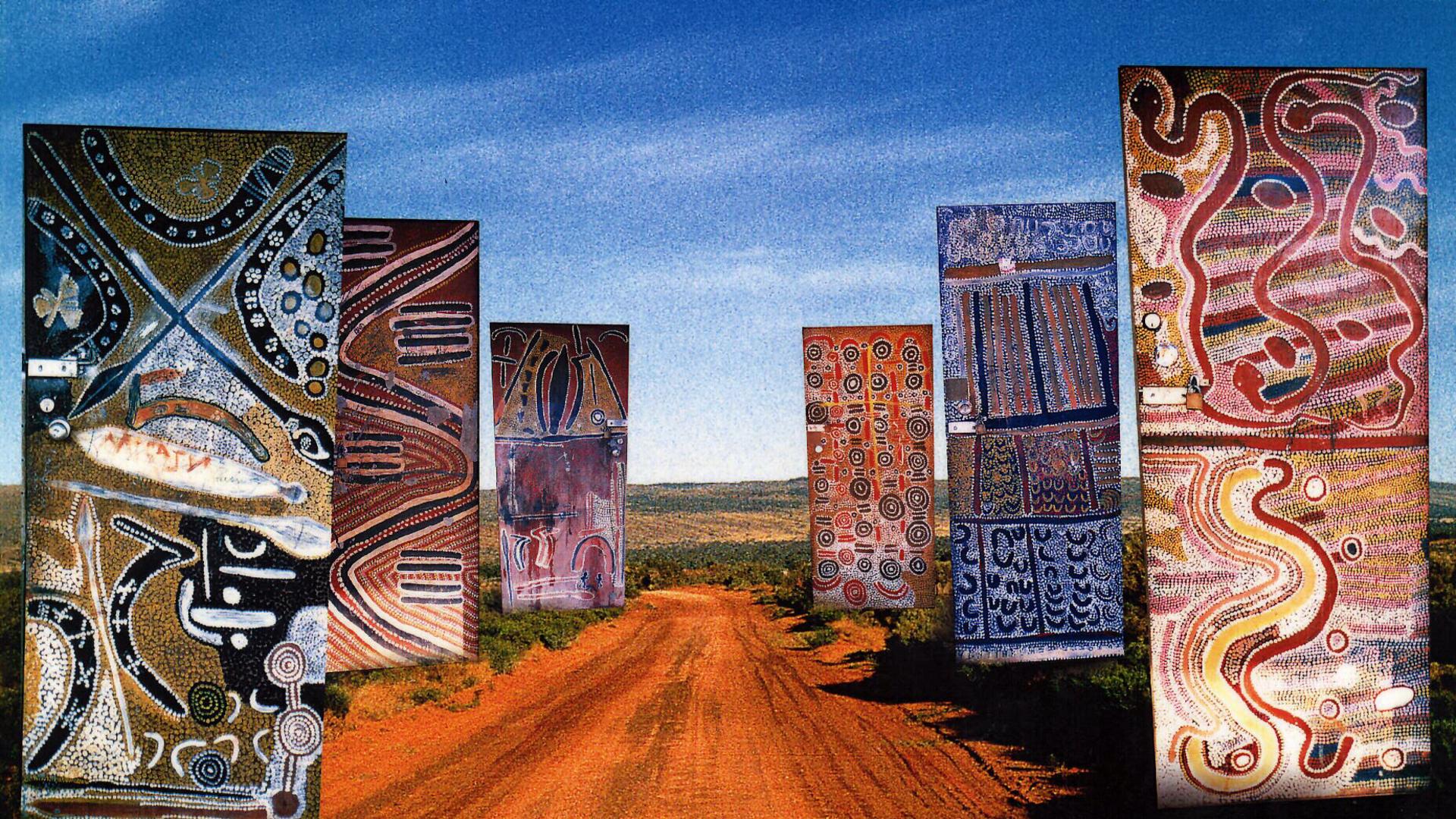
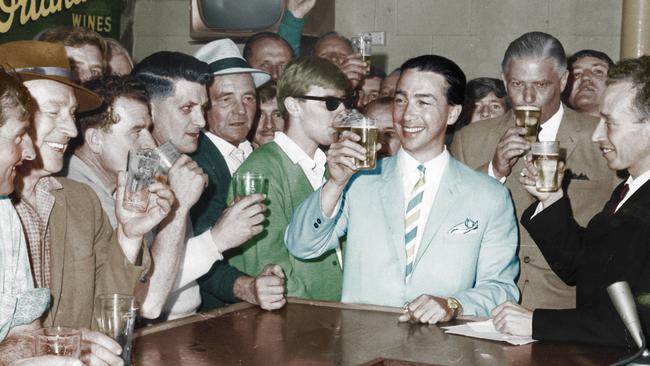
Lockdown Kids docu-series: Covid’s shocking legacy
Spiralling mental health, youth crime and school refusal – this must-see docu-series examines the long-term impacts of placing the nation’s children into Covid lockdowns.
Watch the moment lifeless man yanked from burning wreckage
I was hit by a car going 170km/h and survived. No doubt about it, I should probably be dead. But after I was left unconscious, burning, trapped and helpless, something incredible happened, writes Advertiser journalist Ben Hyde.